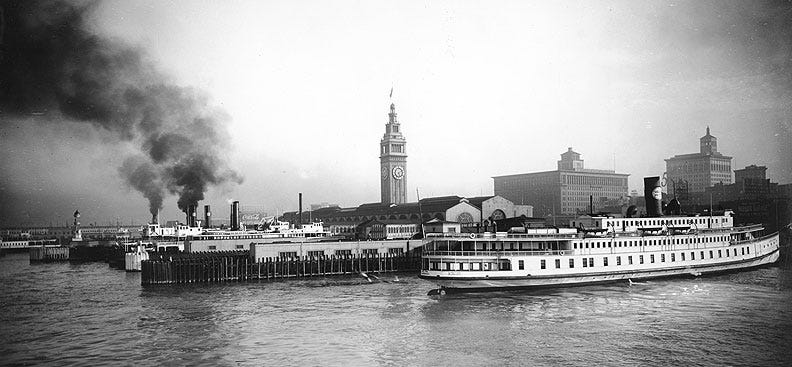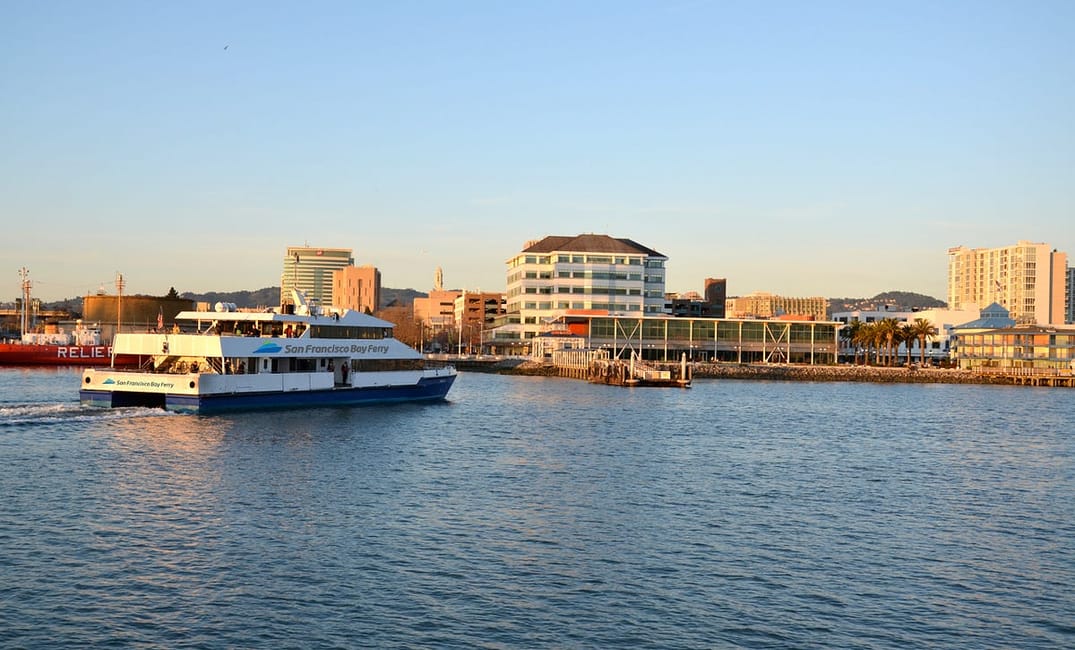
Commuting in the Bay Area is a heinous process. With ever-increasing gridlock and congestion, it’s officially one of the worst places in the country in which to drive. Public transit hasn’t been able to keep up with demand, either — BART is overcrowded (now serving more than 400,000 riders a day), underdeveloped, and plagued with delays.
While most spend their mornings and evenings fighting traffic or crowds, the happiest commuters are arguably the ones sitting pretty on one of the various ferries taking people in and out of San Francisco every day. The ride is luxurious in comparison to the alternatives — you can get a seat, a view, Wi-Fi, and even a beer at the bar in some cases.
Ferry service remains limited in scope and accessibility, and the price tag is high, but given how desperate transit advocates are to get cars off the bay’s bridges and the unreal expense it would take to equip BART for the modern era, adding more of them could help ease up on some of the congestion. Could returning to the method of transit that used to the lifeblood of the Bay Area’s transportation ecosystem be the quick cost-effective solution we’re looking for?
Turns out, SF Bay Ferry is growing exponentially and adding routes to keep up with demand — and even more could become available in the future. It’s an old-fashioned solution for a modern problem, but it might work.
Before the Bay and Golden Gate Bridges debuted in the mid-1930s, ferries were the only way people traversed the bay. At their height in 1935 and 1936, they transported more than 50 million people annually on more than 50 vessels (by comparison, today, the two major ferry agencies together serve a little over five million riders).
It was the golden age of ferry travel, a thriving and integral part of the region’s culture, until the newly built bridges allowed people to drive into downtown San Francisco by the late 1930s. Ferries disappeared completely from the Bay Area by the end of the 1950s.

Ferry service was reinstated in the 1960s as a shadow of its former self, with far fewer trips and vessels and significantly less ridership. The modern-day ferry-service operator, San Francisco Bay Ferry, run by the Water Emergency Transport Authority (WETA), was born as an emergency-response solution founded after the Loma Prieta earthquake in 1989. The state created the agency, which later became WETA, with the goal of providing a way to move first responders and evacuees across the bay if bridges collapse or aren’t safe to traverse.
Emergency preparedness is still a part of the agency’s work, but it also now serves over 2.8 million people in the East and South Bays with commuter ferries that deliver riders to downtown San Francisco, including routes from Oakland, Alameda, Vallejo, and—recently—Richmond. The three ferry terminals in Marin County are run by Golden Gate Transit and serve an additional 2.5 million people. Existing routes are often full, and WETA has projects in the works to expand service to other cities, including Berkeley.
“It’s funny how circular these things are,” said Thomas Hall, WETA’s public information officer. “People used to take ferries all the time, and then we moved away from that. But ferries are becoming attractive again, and people are realizing they make sense.”
As gridlock increases and more commuters live in suburbs and exurbs that are hours from downtown in traffic, WETA has seen a sharp increase in ridership. In fact, demand for WETA’s ferry services in the Bay Area has grown by 94% since 2012.
One of the appeals of ferries is that they are easier to put into place than other major infrastructure projects; building ferry terminals requires much less time than laying down new rail tracks and building train routes.
“Once we have a terminal, as long as we can have access to it and do maintenance, it’s pretty self-sustaining in that way,” Hall said. “There’s not a lot of disruption going forward.”
The recently opened Richmond terminal cost $20 million and took several years to complete; ground was broken in 2017, and service started in January. As infrastructure projects go, it’s actually efficient — and cheap. For comparison, the new BART station under construction in Berryessa, San Jose, which is slated to open near the end of the year, cost $2.3 billion.
Ferries have their drawbacks, though, including environmental impacts due to emissions and wildlife disruption.
Hall says SF Bay Ferry would like to transition its fleet to be fully electric but that right now, electric batteries would make their boats too heavy to run at their current speeds. The world’s first all-electric ferry debuted in Norway in 2015 and cut costs by 80% ; as of March 2018, there were 58 battery-operated ferries in operation. The world’s first hydrogen-fuel-cell ferry, a project of Golden Gate Zero Emission Marine, among other groups, is being launched in the Bay Area in just a few months. Hydrogen fuel cells are another option WETA is considering for their fleet.
Busses are further along in terms of creating clean fleets, because there are so many more of them. Trains, once built, are generally thought to be cleaner than ferries, but they require more significant infrastructure to create, and that process can cause environmental damage too.
Ferries are also expensive per passenger, since they simply can’t carry the number of passengers that a train can. The largest of SF Bay Ferry’s boats can hold 445 passengers total, and most BART trains can hold up to 200 riders per car; some trains have as many as 10 cars.
Ferry fares vary, but they are more expensive than most commuter BART routes; the cheapest SF Bay ferry route — Alameda or Oakland to SF — is $5.40 one way with a Clipper Card, while the most expensive — Vallejo to SF — is $11.30 each way. While ferry terminals are less expensive than other infrastructure projects to build, they still require significant investment from local, state, and federal funding sources. Updates to expand the SF Ferry terminal and add more spots for ferries to dock will cost $98 million.
Another reality is that ferries work only in some cases, so they won’t be as fast or as convenient in some routes. From downtown Oakland to San Francisco’s Embarcadero Station is about a 25-minute ferry ride and an 11-minute train ride (if there are no delays), while the Vallejo route takes about an hour. For areas further inland, such as surburbs in the East Bay, taking a bus or train might be faster than driving to a ferry terminal and then taking the boat.
“The Bay Area is really large…and some transit methods are going to be more effective for a long-transit trip; a high-speed train, for example, will be faster and more efficient,” Hall said.
WETA currently has one of the largest fleets in the country, and even so, there are only 14 boats currently in operation, with three more under construction. That means that if one boat is not functioning, it’s harder to maintain service.
“If something happens to one of those vessels, we can be left scrambling sometimes,” said Hall.
Ferries seem to be a good fit for particular parts of the Bay Area, but they would be impossible to implement due to geography—mainly, the far South Bay, because the water there isn’t deep enough for the WETA ferries’ draft requirements (“draft” refers to the distance between the waterline and the bottom of a ship’s hull, and it’s used to measure the depth that a ship requires to navigate safely).
“[Water depth ] has been a big limiting issue of where we can go in the bay. Our boats do have drafts of roughly seven feet or up, so we can’t really go to too many places in the southern portion of the bay. That’s a big hurdle in terms of trying to use ferries to relieve congestion in the South Bay, on the peninsula,” said Hall.
WETA is currently researching the possibility of hovercraft boats that could be implemented in the shallower parts of the bay, but their current fleet requires depth to function.
Arielle Fleisher, an analyst with the Bay Area planning organization SPUR, sees ferries as an important tool for dealing with immediate transportation needs even as transit analysts actively work on larger-scale solutions, like a second Transbay Tube or even a high-speed rail, which remain more or less theoretical at this point.
“Ferries are a great way to move people across the Bay…it’s a way that we can provide relief in the next few years before there’s another crossing, etc. It is an opportunity to make a dent in traffic and to give people more choices to get around the Bay Area.”
It will be important as ferries grow to consider the “last mile”: how people can get from their homes to the terminal and back again.
“Given where ferry terminals are, how do we get people to the ferry terminals? Ferries are a leg of a journey, and we think need to look at the full customer journey, which might include a bike trip, a car trip, a bus trip…a lot of the attraction of ferries is in that first- and last-mile connection, so we need to think about that,” said Fleisher.
Fleisher explained that in order for ferries to work, they will have to be part of a larger transit overhaul in the Bay Area; increasing ferry service alone won’t solve all the Bay Area’s transit issues, but it will help. Most Bay Area cities need multiple options to keep up with demand.
“I think about our transportation system as Russian dolls. It’s a network, and that’s where it gets its strength from. Ferries are a part of that network, and getting frequent, all-day ferry service can create a stronger network,” said Fleisher.
The collaboration between ferries and other transit modes would work most effectively if pricing were standardized, since at present they vary so dramatically. “We should make it cost-neutral to switch between these different modes using a Clipper Card, which would allow people to choose a different mode each day on the basis of information about congestion or disruption in one system, or their dinner plans,” said Fleisher.
It’s not the 1930s anymore, so ferries aren’t the only way we travel, but they could work well alongside other innovations.
“I really believe that transportation right now is a menu of options. The ferry might work best for me on Tuesday and BART on Wednesday, and a bike on Thursday. It’s really an ecosystem approach, and we need to create a full system that meets people’s needs,” Fleisher said.







